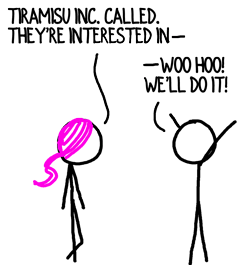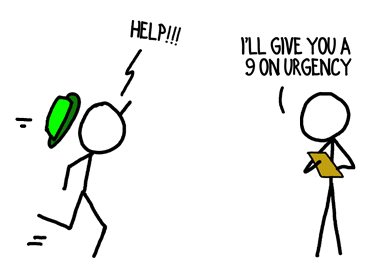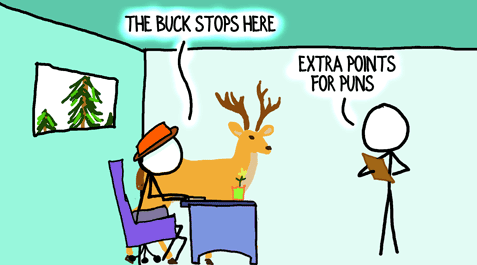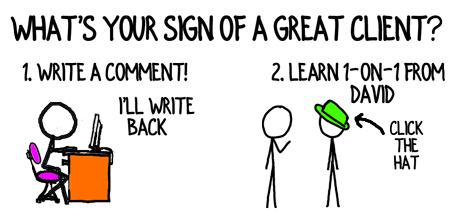What makes a consulting firm exceptional? Yes, tiramisu at lunch every Friday. And what else makes a consulting firm exceptional? Outstanding clients.

Selecting your clients carefully is essential for your consulting firm to grow and provide the rewards you’re looking for.
Working with terrific consulting clients sets the stage for cheerier days and a more lucrative practice. It also magnifies your ability to win additional excellent clients, because:
- Delighted clients rave about your services to other prospective consulting clients;
- Successful outcomes spawn killer case studies you can present to prospects;
- Exciting, fun partnerships perk up everyone in your group, and prospects are more likely to work with an upbeat firm.
Your consulting firm should have a Go/No-Go checklist and scoring rubric for consulting prospects.
Bust out your rubric when you’re actively identifying targets for your firm, when your relationship-nurturing activities reveal a consulting opportunity, and on those happy occasions when a consulting prospect appears out of the blue.
What goes on your Go/No-Go checklist? We’ve talked about prospects to avoid. How do you spot a first-rate consulting client?
10 Signs of a Great Consulting Client
Within Reach
Being able to enter into conversation with a prospect is the #1 attribute of your ideal consulting prospect.
Reachability is critical when you’re defining specific targets for your marketing.
Even when consulting prospects magically appear at your doorstep, ongoing, easy access to the decision-maker is a crucial ingredient for the consulting engagement to succeed.
Displaying Urgency
Your best consulting clients exhibit a burning desire to make progress.
This manifests as quick decision-making and short timetables. For instance, you want a consulting prospect who sets the date for your follow-up conversation within days, rather than weeks.

Likely to Succeed
Stack the deck in your favor by accepting only consulting clients whose outcomes are likely to be favorable.
Compare past consulting projects that succeeded against any that yielded poor outcomes. What were the differences in your clients’ situations, behaviors, attitudes and approaches?
Use those differences to winnow out likely losers and select future winners.
Sufficiently Bankrolled
Great consulting clients have large problems and the budget authority to solve them.
You’re not always looking for the highest-level people in the biggest companies. That said, the size of your prospect’s purse generally is a function of the size of the outcome they’re seeking and their position within their organization.
Clear on the Decision-Making Process
Ideally, your prospect has a single, well-defined decision-maker for your consulting project.
At the very least, the decision process and criteria should be unambiguous.

Not Run by Procurement
Your conversations should be directly with the individual who is struggling with the problem you solve or harboring the aspiration you achieve, not with a procurement manager.
RFPs are not hallmarks of a wonderful client.
Trustworthy
Integrity is important in your consulting firm. It’s just as important in your clients.
Your anxiety is lessened and your workdays brighten when you trust your clients to stand by their decisions and pay you promptly.
This is particularly important if you enter into risk-sharing consulting contracts.
Candid
Similar to trustworthiness, candor is a prize attribute in consulting clients.
Your work is infinitely easier and more likely to succeed when your client is open and honest about their woes, their concerns, internal politics, past successes, and anything else that can affect the process.
By the way, candid clients also are quick to point out when they’re not happy with you or your firm’s work. That’s how you rapidly adjust, achieve success and improve your offering.
Outcome Focused
Sterling consulting prospects are obsessed with the value of achieving their outcome.
By definition, this means the cost of your consulting engagement is not driving their purchase decision, as long as you’re providing a solid return.
? _________
A few other, important attributes on my firm’s Go/No-Go list aren’t in this article (yet), because I want to hear from you too.
It’s time for you to build your Go/No-Go rubric if you don’t have one. What else do you think signals a good prospect for your consulting firm?
Text and images are © 2024 David A. Fields, all rights reserved.

 David A. Fields Consulting Group
David A. Fields Consulting Group 

David,
How about “Engaged in the process”?
The best clients want to be involved in the project, they want to assign strong internal players to be part of the consulting team to get a transfer of skills and a deep internal understanding of the thinking behind the results.
On a side note: a great way to recognize a fantastic client is to seek to become one yourself. A consultant who believes that it makes sense for clients to pay a premium to hire a top tier adviser can role model that behavior by hiring a great accountant, attorney, graphic designer.
Two, outstanding points, Will. An engaged prospect is certainly a positive sign and portends an engaged client. For our part, we can keep our clients engaged by including them throughout the process, too.
Your recommendation that we behave with our consulting firms the way we’d like our clients to behave–i.e., investing in premium talent–is right on the mark. A consulting firm that skimps on support functions, be they book editors, website designers or attorneys, is not well positioned to demand a premium.
Thanks for the excellent insights, Will.
Great article.
One I would add is Partnetship.
I want my client to be rowing with me to his/her destination.
Joe, you hit the #2 attribute on my firm’s list. (#1 is reachable, of course.) We value a partnership approach and will turn down clients who view us as a vendor rather than a partner. The same goes for the consultants I hire and the consulting firms I mentor/guide: I strive to create partnerships with them that are long-lasting and invested beyond the contract.
You highlighted a key attribute, Joe. Great add.
Urgent need by no means guarantees a partnership approach.
You’re absolutely right, Anatoli. It would be ideal if all of these attributes always came together in a package, wouldn’t it?!
David—
Great article. However, I take issue with your comment about RFPs. Those of us who work for public sector clients understand that RFPs are a way of life. I’ve had many great clients that we won through RFP processes. You can tell a lot in advance through an RFP, like whether or not the project is well defined or the process is not overly proscribed.
Catherine, you’ve raised an interesting point about RFPs. You’re absolutely right that you can learn a lot about a client from the RFP and that a poorly constructed RFP is the sign of a bad client. On the other hand, I haven’t found that a public-sector RFP is ever the sign of a great client.
Good for you for coming to the defense of consultancies that focus on the public sector!
Good points, as usual. Three additional things from my experience. First, when I present my first in the world to the best of my knowledge training on software acquisition and outsourcing, I always emphasize the importance of being a good client for getting better outcomes. Too many prospective acquirers approach it with an adversarial view toward the folks they’re considering engaging. Just as an aside, an appropriate RFP in fact is a valuable part of the process and when done right (unlike most, I acknowledge) aids in developing better engagements, relationships, and outcomes.
Second, it’s not all a one-way street. Great clients are not just sitting around waiting to be picked up; and few of us that I know of can afford to wait for only perfect clients. It’s the same with husbands, just ask your wife (I can’t speak about the other pairing, but I know my wife is perfect—she tells me so, and I’ve heard other husbands recount similar situations). The consultant is a critical element in making a good client.
Third, a related concept. I know a fellow consultant, who at one time was a major source of my business, who is convinced there just aren’t any good clients out there. He was specifically referring at the time to inability to generate IT consulting business in Silicon Valley. He was and unfortunately still is unwilling to recognize and take appropriate action to keep his email list up-to-date and filled with reasonable prospects.
Clients are responsible for the outcome of their consulting projects, and if a consulting project fails to deliver, I put the blame squarely on the client. That’s the message in this book.
That said, the blame goes squarely on the consulting firm too. Projects are always shared responsibility. If they could achieve the outcome without us, they would. If we could achieve the outcome without them, we’d have a syndicated product not a consulting offering.
Re clients waiting around: in fact, there are tons of clients looking for the right consultant. With over $300 billion spent on management consulting every year (and over $1 trillion if you expand that to all advisory services), there’s plenty of room to turn down bad clients.
I understand taking on a sub-optimal client when times are tight. It’s virtually never worth taking on a bad client, though. Bad business crowds out good business.
Finally, and most importantly, my better half is perfect. (Saying otherwise could jeopardize the steady flow of chocolate treats coming my way.)
A very good point, Robin: best clients are grown, not picked up.
Simply because if a great client is ripe for service, it’s a good chance they already have a consultant. Same goes for great wives 😉
Our team went through this process several months ago about identifying who would not be good clients. Some comments echo what has been said about slow follow through during the initial process. That is frequently a harbinger of doom – unless you’re working with the requisite procurement person who does not allow direct access. Once through that process, the path is typically easier.
Frankly, I let my potential clients know that I am interviewing them just as much as they are interviewing me because I tell them so. I let them know that I don’t choose just anyone. It’s not manipulative, it’s true. If they don’t want candor, my team is not correct for them and it won’t be a productive partnership. If they don’t look at the engagement as a partnership, it’s not going to be successful. I listen for key words in their conversations to identify whether there will be a blame game or not. Are they respectful of your time and how they talk to you? [On the flip side, be respectful of their time and know what you want to learn from them and keep within their time constraints.]
Also, if they don’t really know the outcome that they want, and your job as the consultant isn’t necessarily to define it in the project, you’re not going to reach the target that isn’t there. Do they have support of their direct boss or above? If not, no go. Those that are nickel and dimng you on the project, not a good relationship, as price is more important than quality. I don’t negotiate on price; I negotiate on scope. I respectfully let them know that I can refer them to colleagues who can probably meet their monetary constraints. EVEN WHEN HUNGRY FOR WORK, choose clients wisely. As a consultant, your reputation is paramount, and it’s a very small world out there. I learned that from Alan Weiss’ Million Dollar Consultant book early on. It has served me well.
After acquisition, I contact clients periodically (gratis, as customer service), to see how they are doing with the consulting team and identify any barriers. Yesterday I got the words “They are awesome! They bring great expertise that we need!” You are their client, and you need to be communicating with them and showing that you care. We are half of the equation of the partnership. Sometimes it seems more than half, but that’s the case with marriage too, isn’t it?
Susan, much of your excellent and eloquent commentary mirrors my reply to Robin G., above. We’re definitely thinking along the same lines!
Internal alignment is also on my teams Go/No-Go list because, as you pointed out, if the boss (or peers or subordinates) aren’t fully on board, the project can be much, much more difficult. I’m glad you underscored that idea.
It sounds like you have excellent client-choosing tactics. Congratulations on that.
Finally, a little teaser: rather than negotiating price or scope, negotiate risk. That’s where the value actually resides. (More on that in my next book.)